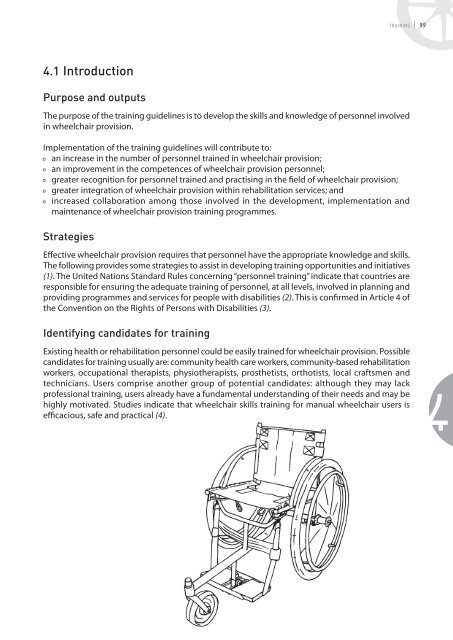Manual Wheelchairs - World Health Organization
Manual Wheelchairs - World Health Organization
Manual Wheelchairs - World Health Organization
You also want an ePaper? Increase the reach of your titles
YUMPU automatically turns print PDFs into web optimized ePapers that Google loves.
4.1 Introduction<br />
Purpose and outputs<br />
traInIng I 99<br />
The purpose of the training guidelines is to develop the skills and knowledge of personnel involved<br />
in wheelchair provision.<br />
Implementation of the training guidelines will contribute to:<br />
• an increase in the number of personnel trained in wheelchair provision;<br />
• an improvement in the competences of wheelchair provision personnel;<br />
• greater recognition for personnel trained and practising in the field of wheelchair provision;<br />
• greater integration of wheelchair provision within rehabilitation services; and<br />
• increased collaboration among those involved in the development, implementation and<br />
maintenance of wheelchair provision training programmes.<br />
Strategies<br />
Effective wheelchair provision requires that personnel have the appropriate knowledge and skills.<br />
The following provides some strategies to assist in developing training opportunities and initiatives<br />
(1). The United Nations Standard Rules concerning “personnel training” indicate that countries are<br />
responsible for ensuring the adequate training of personnel, at all levels, involved in planning and<br />
providing programmes and services for people with disabilities (2). This is confirmed in Article 4 of<br />
the Convention on the Rights of Persons with Disabilities (3).<br />
Identifying candidates for training<br />
Existing health or rehabilitation personnel could be easily trained for wheelchair provision. Possible<br />
candidates for training usually are: community health care workers, community-based rehabilitation<br />
workers, occupational therapists, physiotherapists, prosthetists, orthotists, local craftsmen and<br />
technicians. Users comprise another group of potential candidates: although they may lack<br />
professional training, users already have a fundamental understanding of their needs and may be<br />
highly motivated. Studies indicate that wheelchair skills training for manual wheelchair users is<br />
efficacious, safe and practical (4).<br />
4

















